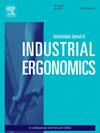行人与轮椅使用者的社会共情与互动:使用者手势与行动辅助设计的影响
IF 3
2区 工程技术
Q2 ENGINEERING, INDUSTRIAL
International Journal of Industrial Ergonomics
Pub Date : 2025-08-03
DOI:10.1016/j.ergon.2025.103793
引用次数: 0
摘要
轮椅使用者在公共场所遇到各种无障碍挑战,这可能导致他们在困难的情况下寻求行人的帮助。在此背景下,了解影响行人移情和与wu互动的因素有助于他们在充满挑战的城市环境中进行社会互动。本研究探讨轮椅使用者的肢体动作与轮椅设计特征(wdc)对行人感知与互动的影响。对52名参与者进行了一项试验性横断研究,分两个阶段进行:(1)问卷调查,评估使用独立或寻求帮助手势的轮椅的意愿;(2)使用外观和社会感知的关键语义描述符评估从传统到高级的四种轮椅类型。研究结果显示,在两种手势条件下,年龄、性别和互动意愿之间没有显著关系(p >;在寻求帮助的手势条件下,年龄与与高级电动轮椅使用者互动的意愿之间存在显著关联(p = 0.027)。此外,当wu表现出求助手势时,行人的互动意愿显著高于独立手势(p <;0.001)。当WUs表现出独立性(86.3%)时,wdc对行人感知的影响比寻求帮助的手势(50%)更大。此外,语义评估分析揭示了高级手动轮椅和电动轮椅的不同感知维度,每种轮椅都确定了三个主要组成部分,为开发更具社交性的轮椅提供了有价值的见解。本研究强调WDC和用户手势都显著影响行人交互,其中帮助手势对WDC的掩盖效应是一个关键发现。此外,先进的wdc标志着wu的独立性,有助于减少行人的负面社会刻板印象。本文章由计算机程序翻译,如有差异,请以英文原文为准。
Pedestrians’ social empathy and interaction with wheelchair Users: The impact of user gestures and mobility aid design in a pilot study
Wheelchair users (WUs) experience various accessibility challenges in public spaces, which may lead them to seek assistance from pedestrians in difficult situations. In this context, understanding the factors influencing pedestrians' empathy and interaction with WUs facilitates their social interactions in challenging urban situations. This study examines how WUs’ body gestures and wheelchair design characteristics (WDCs) impact pedestrian perception and interaction. A pilot cross-sectional study was conducted with 52 participants in two phases: (1) a questionnaire assessing willingness to engage with WUs exhibiting independent or help-seeking gestures, and (2) evaluating four wheelchair types—from conventional to advanced—using key semantic descriptors of appearance and social perception. Findings revealed no significant relationship between age, gender, and willingness to interact across the two gesture conditions (p > 0.05), except for a significant association between age and willingness to interact with users of advanced powered wheelchairs in the help-seeking gesture condition (p = 0.027). Also, pedestrians' willingness to interact was significantly higher when WUs exhibited help-seeking gestures compared to independence gestures (p < 0.001). WDCs influenced pedestrian perceptions more strongly when WUs displayed independence (86.3 %) than help-seeking gestures (50 %). Moreover, analysis of semantic evaluations revealed distinct perceptual dimensions for advanced manual and powered wheelchairs, with three principal components identified for each, offering valuable insights for developing wheelchairs with greater social polish. This study highlights that both WDC and user gestures significantly affect pedestrian interaction, with the masking effect of help gestures on WDCs being a key finding. Additionally, advanced WDCs signify WUs' independence, helping reduce negative social stereotypes among pedestrians.
求助全文
通过发布文献求助,成功后即可免费获取论文全文。
去求助
来源期刊
CiteScore
6.40
自引率
12.90%
发文量
110
审稿时长
56 days
期刊介绍:
The journal publishes original contributions that add to our understanding of the role of humans in today systems and the interactions thereof with various system components. The journal typically covers the following areas: industrial and occupational ergonomics, design of systems, tools and equipment, human performance measurement and modeling, human productivity, humans in technologically complex systems, and safety. The focus of the articles includes basic theoretical advances, applications, case studies, new methodologies and procedures; and empirical studies.

 求助内容:
求助内容: 应助结果提醒方式:
应助结果提醒方式:


